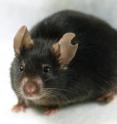When cloning mice, a little drop of blood'll do ya
Related images
(click to enlarge)
From obesity to substance abuse, from anxiety to cancer, genetically modified mice are used extensively in research as models of human disease. Researchers often spend years developing a strain of mouse with the exact genetic mutations necessary to model a particular human disorder. But what if that mouse, due to the mutations themselves or a simple twist of fate, was infertile? Currently, two methods exist for perpetuating a valuable strain of mouse. If at least one of the remaining mice is male and possesses healthy germ cells, the best option is intracytoplasmic sperm injection (ICSI), an in vitro fertilization procedure in which a single sperm is injected directly into an egg.
However, if the remaining mice cannot produce healthy germ cells, or if they are female, researchers must turn to cloning. Somatic-cell nuclear transfer (SCNT) produces cloned animals by replacing an oocyte's nucleus with that of an adult somatic cell. An early version of this process was used to produce Dolly the sheep in 1996.
Since then, SCNT techniques have continued to advance. Earlier this year, researchers at the RIKEN Center for Developmental Biology in Kobe, Japan, even devised a technique to avoid the diminishing returns of recloning the same cell; success rates increased from the standard three percent in first-generation clones to ten percent in first-generation and 14 percent in higher-generation clones.
The type of somatic cell used for this process is critical and depends largely on its efficiency in producing live clones, as well as its ease of access and readiness for experimental use. While cumulus cells, which surround oocytes in the ovarian follicle and after ovulation, are currently the preferred cell type, Drs. Satoshi Kamimura, Atsuo Ogura, and colleagues at the RIKEN BioResource Center in Tsukuba, Japan, questioned whether white blood cells (a.k.a., leukocytes) collected from an easily accessed site, such as a tail, would be effective donor cells. Such cells would allow for repeated sampling with minimal risk to the donor mouse.
There are five different types of white blood cells and, as expected, the researchers found that lymphocytes were the type that performed the most poorly: only 1.7 percent of embryos developed into offspring. The physically largest white blood cells, and thus the easiest to filter from the blood sample, were granulocytes and monocytes. The nuclei of these cells performed better, with 2.1 percent of the embryos surviving to term, compared to 2.7 percent for the preferred cell type, cumulus cells.
The granulocytes' performance was poorer than expected due to a much higher rate of fragmentation in early embryos (22.6 percent): twofold higher than that of lymphocyte cloning and fivefold higher than cumulus cell cloning. The researchers were unable to determine what could be causing the fragmentation and intend to perform further studies to improve the performance of granulocyte donor cells.
Although the blood cells tested did not surpass the success rate of cumulus cells in this study, the researchers have demonstrated, for the first time, that mice can be cloned using the nuclei of peripheral blood cells. These cells may be used for cloning immediately after collection with minimal risk to the donor, helping to generate genetic copies of mouse strains that cannot be preserved by other assisted reproduction techniques.
Source: Society for the Study of Reproduction
Other sources
- VIDEO: Mouse cloned from one blood dropfrom BBC News: Science & NatureThu, 27 Jun 2013, 21:00:31 UTC
- Japanese scientists use blood cells from one mouse to clone anotherfrom UPIThu, 27 Jun 2013, 19:00:25 UTC
- Mouse Cloned From A Mere Drop Of Bloodfrom PopSciThu, 27 Jun 2013, 17:30:29 UTC
- Mouse cloned from drop of bloodfrom BBC News: Science & NatureThu, 27 Jun 2013, 10:00:30 UTC
- Cloning mice: For the first time, a donor mouse has been cloned using a drop of peripheral blood from its tailfrom Science DailyWed, 26 Jun 2013, 20:30:41 UTC
- For the first time, a donor mouse has been cloned using a drop of peripheral blood from its tailfrom PhysorgWed, 26 Jun 2013, 19:30:38 UTC
